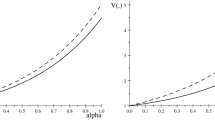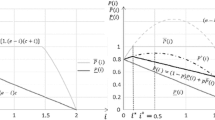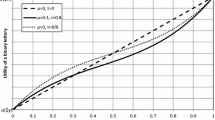Abstract
This work studies the implications of some aspects of preferences toward risk in the choice between two binary lotteries exhibiting a common consequence. The results obtained are then applied to two different problems: the choice between two risky challenges characterized by different rewards in the case of success and different probabilities of success and the choice between self-protection and self-insurance in the presence of the risk of incurring financial loss.




Similar content being viewed by others
Notes
We emphazise that this idea of challenge, although significatly different, is potentially related to the concept of contests between agents, first introduced by Tullock (1980) and Dixit (1987) and more recently extended to the case of risk averse agents (e.g. Konrad and Schlesinger 1997; Treich 2010 and Liu et al. 2018). This literature considers many agents competing in a contest where reward is a kind of rent. Our framework examines instead the optimal choice of a single agent, who has to choose between different challenges whose probability of success is given. Moreover, the goal of the contest models is the study of the level of effort in a (Nash) equilibrium, while our aim is the analysis of the role of the attitude toward risk in the choice between challenges. All this suggests a possible complementarity between the approach in the literature studying contests and our approach in considering the choice between risky challenges.
We have, for instance, a symmetric distribution when the risk has normal or uniform distribution, but clearly this also occurs for many other distributions.
Eeckhoudt and Schlesinger (2006) show that mixed risk aversion can be seen as the wish of risk apportionment in the sense that an agent who exhibits these preferences desires to implement different kinds of harm disaggregation. Mixed risk aversion has also proved to be relevant in many economic applications (e.g. Eeckhoudt and Schlesinger 2006; Crainich et al. 2016). Lastly, on the characterization of mixed risk aversion, see also Menegatti (2015).
As for W0, we may define \(W_{1}=\bar {W}_{1}-c\), where \(\bar {W}_{1}\) is gross wealth (excluding the cost c).
References
Brockett, P.L., & Golden, L.L. (1985). A class of utility functions containing all the common utility functions. Management Science, 33, 955–964.
Caballé, J., & Pomanski, A. (1996). Mixed risk aversion. Journal of Economic Theory, 71, 485–513.
Crainich, D., Eeckhoudt, L., Menegatti, M. (2016). Changing risks and optimal effort. Journal of Economic Behavior and Organization, 125, 97–106.
Crainich, D., Eeckhoudt, L., Trannoy, A. (2013). Even (mixed) risk lovers are prudent. American Economic Review, 103, 1529–1535.
Di Crescenzo, A. (1999). A probabilistic analogue of the mean value theorem and its applications to reliability theory. Journal of Applied Probability, 36, 709–716.
Dionne, G., & Eeckhoudt, L. (1985). Self-insurance, self-protection and increased risk aversion. Economics Letters, 17, 39–42.
Dixit, A. (1987). Strategic behavior in contests. American Economic Review, 77, 891–898.
Eeckhoudt, L., & Schlesinger, H. (2006). Putting risk in its proper place. American Economic Review, 96, 280–289.
Ehrlich, L., & Becker, G. (1972). Market insurance, self insurance and self protection. Journal of Political Economy, 80, 623–648.
Konrad, K.A., & Schlesinger, H. (1997). Risk aversion in rent-seeking and rent-augmenting games. Economic Journal, 107, 1671–1683.
Hofmann, A., & Peter, R. (2016). Self-insurance, self-protection, and saving: On consumption smoothing and risk management. Journal of Risk and Insurance, 83(3), 719–734.
Liu, L., Meyer, J., Rettenmaier, A.J., Saving, T.R. (2018). Risk and risk aversion effects in contests with contingent payments. Journal of Risk and Uncertainty, 56, 289–305.
Menegatti, M. (2015). New resuts on high-order risk changes. European Journal of Operational Research, 243, 678–681.
Rothschild, M., & Stiglitz, J.E. (1970). Increasing risk I: A definition. Journal of Economic Theory, 2, 225–243.
Snow, A. (2011). Ambiguity aversion and the propensities for self-insurance and self-protection snow. Journal of Risk and Uncertainty, 42, 27–43.
Treich, N. (2010). Risk-aversion and prudence in rent-seeking games. Public Choice, 145, 339–349.
Tullock, G. (1980). Efficient rent-seeking. In Buchanan, J. M., Tollison, R. D. , Tullock, G. (Eds.) (pp. 97–112). College Station: Texas A. and M. University Press.
Author information
Authors and Affiliations
Corresponding author
Additional information
Publisher’s note
Springer Nature remains neutral with regard to jurisdictional claims in published maps and institutional affiliations.
Appendices
Appendix A
Lemma 1
Given the two non-negative random variables Xand Ysatisfying YFSD ≥ Xand\(E[X]<E[Y]<+\infty \), let Zbe the random variable with probability density function
with t ≥ 0 and where\(\bar {F}_{X}\)and\(\bar {F}_{Y}\)are the survival functions of Xand Y. If g(.) is a measurable and differentiable function such that E[g(X)] and E[g(Y )] are finite then E[g′(Z)] is finite and
Proof
See Di Crescenzo (1999), Proposition 3.1 and Theorem 4.1 . □
Appendix B
We prove here that \(\tilde {z}\) dominates \(\tilde {s}\) via first order stochastic dominance. Given the functions \(F_{\tilde {z}}(.)\) and \(F_{\tilde {s}}(.)\) which are the cumulative distribution functions of \(\tilde {s}\) and \(\tilde {z}\), \(\tilde {z}\) dominates \(\tilde {s}\) via first order stochastic dominance if \(G(j)=F_{\tilde {s}}(j)-F_{\tilde {z}}(j)\geq 0\) for every j with a strict inequality for some j. Also note that \(\frac {dG}{dj}=f_{\tilde {s}}(j)-f_{\tilde {z}}(j)\) where \(f_{\tilde {s}}(j)\) and \(f_{\tilde {z}}(j)\) are the density functions of \(\tilde {s}\) and \(\tilde {z}\) respectively. By applying Proposition 3.1 in Di Crescenzo 1999 (see again Appendix A), we obtain:
where \(\bar {F}_{U(\tilde {x}_{1})}(j)\) and \(\bar {F}_{U(\tilde {y}_{1})}(j)\) denote the survival function of the random variables \(U(\tilde {x}_{1})\) and \(U(\tilde {y}_{1})\) respectively, and
This implies that:
It is clear that \(f_{\tilde {s}}(j)<f_{\tilde {z}}(j)\) for j ≥ k1 and that \(f_{\tilde {s}}(j)>f_{\tilde {z}}(j)\) for j < x0. Moreover, since \(\bar {F}_{U(\tilde {x}_{1})}(k_{1})=0\) and \(\bar {F}_{U(\tilde {x}_{1})}(k_{0})=1\) and \(\bar {F}_{U(\tilde {x}_{1})}(.)\) is a decreasing function in the interval [k0, k1] there exist a value j0 ∈ [k0, k1] such that \(f_{\tilde {s}}(j)<f_{\tilde {z}}(j)\) for j > j0 and that \(f_{\tilde {s}}(j)>f_{\tilde {z}}(j)\) for j < j0. All this implies that G(j) = 0 for j ≥ k3, G(j) = 0 for j < x0, G(j) increasing for j < j0 and G(j) decreasing for j > j0. This implies, in turn, that G(j) ≥ 0 ∀j ∈ [x0, k3] with a strict inequality for some j, which, as shown above, means that \(\tilde {z}\) dominates \(\tilde {s}\) via first order stochastic dominance.
Rights and permissions
About this article
Cite this article
Crainich, D., Eeckhoudt, L. & Menegatti, M. Some implications of common consequences in lotteries. J Risk Uncertain 59, 185–202 (2019). https://doi.org/10.1007/s11166-019-09314-4
Published:
Issue Date:
DOI: https://doi.org/10.1007/s11166-019-09314-4




